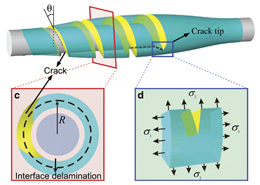二軸応力によって制御される三次元らせん状亀裂
Biaxial stress controlled three-dimensional helical cracks.
2012年4月20日 NPG Asia Materials 4, e4 (2012) doi:10.1038/am.2012.26
応力下の材料:ねじれた亀裂

材料に応力をかけると亀裂が入りやすくなる。亀裂によって材料は破壊することもあるが、意図的に亀裂を誘発すれば有用な製造手段となる。いずれの場合も、亀裂の入り方を制御・予測する方法がわかれば、材料の設計や合成に役立つであろう。しかしながら、亀裂を制御するのは難しい。陶器に入った亀裂がランダムな方向に伸びているのが、そのいい例だ。Yong Zhaoをはじめとする研究チームはこのたび、特定の位置にらせん状亀裂が入るコア-シェル型ファイバーを作製した。これは、コアとなる高靭性ガラスファイバーに、シェルとなる脆性金属酸化物膜をディップコーティング法でコーティングしたもので、脆性金属酸化物膜には一定間隔で紡錘形の節が設けられている。これを焼成すると、高靭性コアと脆性シェルの熱膨張が異なるために、軸方向応力と周方向応力が発生し、この応力が節の部分に亀裂をもたらすことにより、らせん状のコイルが形成される。このとき、コイルの形状は最初の形成過程に依存する。今回の研究結果により、「制御可能な破壊」の実現がさらに一歩近付くだろう。
Materials under stress: A cracking twist
Materials are prone to crack under stress — this can either cause materials failure or, when deliberately induced, offer a useful manufacturing step. In both situations, knowing how to control and predict how materials crack will help in their design and synthesis. Yet exerting control is difficult — for example, we have all seen pottery cracked along random directions. Yong Zhao and co-workers have now prepared core–shell fibres that undergo helical cracking at specific positions. A tough glass fibre was dip-coated with a brittle metal oxide film featuring regular spindle knots. On calcination, the thermal expansion undergone by the tough core does not match that of the brittle shell, creating longitudinal and circumferential stresses. The stress lines in turn cause the knots to crack into helical coils, whose shapes depend on the initial formation process. These findings represent a step forward along the way of controllable fracture.

